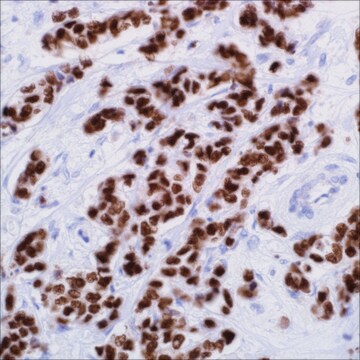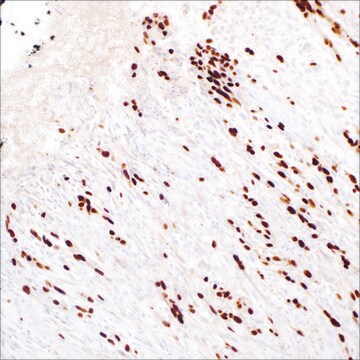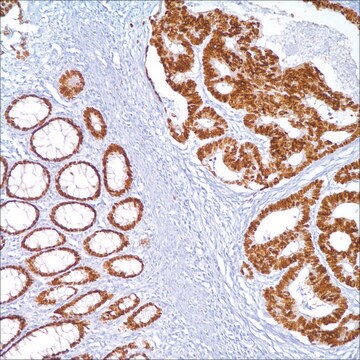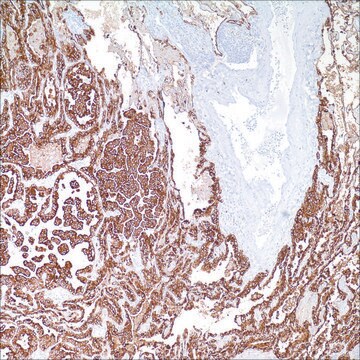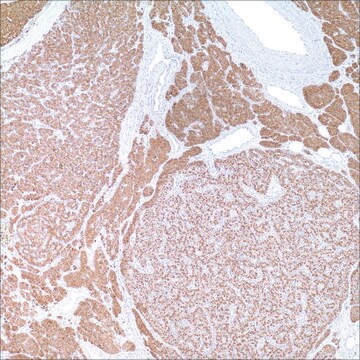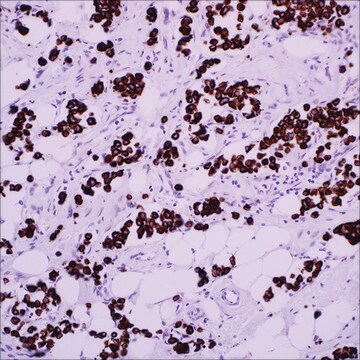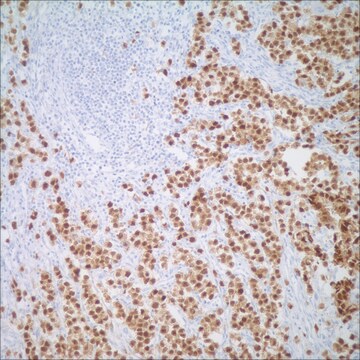推薦產品
生物源
mouse
品質等級
100
500
共軛
unconjugated
抗體表格
diluted ascites fluid
抗體產品種類
primary antibodies
無性繁殖
MRQ-2, monoclonal
描述
For In Vitro Diagnostic Use in Select Regions (See Chart)
形狀
buffered aqueous solution
物種活性
human
包裝
vial of 0.1 mL concentrate (308M-14)
vial of 0.5 mL concentrate (308M-15)
bottle of 1.0 mL predilute (308M-17)
vial of 1.0 mL concentrate (308M-16)
bottle of 7.0 mL predilute (308M-18)
製造商/商標名
Cell Marque®
技術
immunohistochemistry (formalin-fixed, paraffin-embedded sections): 1:25-1:100
同型
IgG1κ
控制
tonsil
運輸包裝
wet ice
儲存溫度
2-8°C
視覺化
nuclear
基因資訊
human ... POU2F2(5452)
一般說明
Octamer-binding transcription factor-2 (Oct-2) is a transcription factor of the POU homeo-domain family. It binds to Ig gene octamer sites and plays a crucial role in B-cell development and differentiation, as well as in B-cell identity. Oct-2 is expressed in a subset of normal B-lymphocytes and is expressed in various B-cell lymphomas as well as nodular lymphocyte predominant Hodgkin lymphoma, while it is typically not expressed in the Reed–Sternberg and Hodgkin (RS/H) cells of classical Hodgkin lymphoma.
Oct-2 is a transcription factor of the POU homeo-domain family that binds to the Ig gene octamer sites, regulating B-cell-specific genes. These are involved in proliferation and differentiation and despite the scarce evidence for Oct-2 expression in T cells, it has been shown that this factor participates in transcriptional regulation during T-cell activation. Oct-2 activity is dependent on phosphorylation and alternatitive splicing, although it seems that the level of its expression can be used as a marker of B-cell lineage and differentiation. The following show high levels of Oct-2 expression: germinal center B-cells, mantle B-cells, monocytoid B-cells, and plasma cells. Various lymphomas are also positive for this marker including the following: B-chronic lymphocytic leukemia, mantle cell lymphoma, follicular lymphoma, marginal zone lymphoma, plasmacytoma, Burkitt lymphoma, diffuse large cell lymphoma, diffuse large B-cell lymphoma, T-cell rich B-cell lymphoma, nodular lymphocyte predominant Hodgkin lymphoma, classic Hodgkin lymphoma.
Several studies of Oct-2 expression have shown a low level expression in pre-B, T-cell, myelomonocytic, and epithelial cell lines, whereas all mature B-cell lines display high levels of expression. Analysis of Oct-2 expression in primary Hodgkin’s lymphoma (HLs) and cell lines derived from it showed that the tumor cells analyzed had high levels of expression and activity, suggesting a common B-cell origin for all types of HLs.
Associated products: bcl-6, CD20, CD79a, PAX-5, BOB.1
Oct-2 is a transcription factor of the POU homeo-domain family that binds to the Ig gene octamer sites, regulating B-cell-specific genes. These are involved in proliferation and differentiation and despite the scarce evidence for Oct-2 expression in T cells, it has been shown that this factor participates in transcriptional regulation during T-cell activation. Oct-2 activity is dependent on phosphorylation and alternatitive splicing, although it seems that the level of its expression can be used as a marker of B-cell lineage and differentiation. The following show high levels of Oct-2 expression: germinal center B-cells, mantle B-cells, monocytoid B-cells, and plasma cells. Various lymphomas are also positive for this marker including the following: B-chronic lymphocytic leukemia, mantle cell lymphoma, follicular lymphoma, marginal zone lymphoma, plasmacytoma, Burkitt lymphoma, diffuse large cell lymphoma, diffuse large B-cell lymphoma, T-cell rich B-cell lymphoma, nodular lymphocyte predominant Hodgkin lymphoma, classic Hodgkin lymphoma.
Several studies of Oct-2 expression have shown a low level expression in pre-B, T-cell, myelomonocytic, and epithelial cell lines, whereas all mature B-cell lines display high levels of expression. Analysis of Oct-2 expression in primary Hodgkin’s lymphoma (HLs) and cell lines derived from it showed that the tumor cells analyzed had high levels of expression and activity, suggesting a common B-cell origin for all types of HLs.
Associated products: bcl-6, CD20, CD79a, PAX-5, BOB.1
品質
 IVD |  IVD |  IVD |  RUO |
聯結
Oct-2 Positive Control Slides, Product No. 308S, are available for immunohistochemistry (formalin-fixed, paraffin-embedded sections).
外觀
Solution in Tris Buffer, pH 7.3-7.7, with 1% BSA and <0.1% Sodium Azide
準備報告
Download the IFU specific to your product lot and formatNote: This requires a keycode which can be found on your packaging or product label.
其他說明
For Technical Service please contact: 800-665-7284 or email: service@cellmarque.com
法律資訊
Cell Marque is a registered trademark of Merck KGaA, Darmstadt, Germany
未找到適合的產品?
試用我們的產品選擇工具.
儲存類別代碼
12 - Non Combustible Liquids
水污染物質分類(WGK)
WGK 2
閃點(°F)
Not applicable
閃點(°C)
Not applicable
從最近期的版本中選擇一個:
分析證明 (COA)
Lot/Batch Number
Christian Hallermann et al.
Journal of the American Academy of Dermatology, 56(4), 588-597 (2007-02-10)
There is a growing body of literature that has enhanced our understanding of the biology of primary cutaneous diffuse large B-cell lymphoma (PCDLBCL) including in the context of gene profiling studies. Recent studies have demonstrated an activated proliferation profile associated
Mónica García-Cosío et al.
Modern pathology : an official journal of the United States and Canadian Academy of Pathology, Inc, 17(12), 1531-1538 (2004-07-17)
Hodgkin's lymphoma can be considered in most cases a B-cell lymphoma due to the presence of potentially functional immunoglobulin (Ig) gene rearrangements in the neoplastic cells. In contrast to lymphocyte-predominant Hodgkin's lymphoma, Hodgkin/Reed-Sternberg (HRS) cells from classical Hodgkin's lymphoma have
Patrick Browne et al.
American journal of clinical pathology, 120(5), 767-777 (2003-11-12)
Even with routine immunohistochemical evaluation, distinguishing classic Hodgkin lymphoma (CHL) from diffuse large B-cell lymphoma (DLBCL) or anaplastic large cell lymphoma (ALCL) can be difficult. In these cases, the transcription factors (B cell-specific activator protein [BSAP], octamer-binding transcription factor 2
Sarah E Gibson et al.
American journal of clinical pathology, 126(6), 916-924 (2006-11-01)
The aberrant expression of the B-cell transcription factor PAX5 has been described in a subset of acute myeloid leukemia (AML) with t(8;21)(q22;q22) in association with B-cell antigen expression. However, the expression of other B cell-associated transcription factors, particularly OCT-2 and
我們的科學家團隊在所有研究領域都有豐富的經驗,包括生命科學、材料科學、化學合成、色譜、分析等.
聯絡技術服務